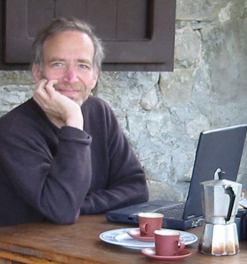Hundreds of millions of people heard the word Chabad for the first time yesterday, when it was revealed that the Chabad Jewish Centre had been one of the targets taken over by Islamist terrorists in Mumbai. The highly disciplined, well trained, and well armed attackers were after “foreigners,” the news reports said; apparently foreigners included not just Israelis, but Jews.
(Note: I discussed these events on CNN the same day I posted this: Konner on CNN )
Heavily armed Indian army commandos rappelled down from helicopters early Friday onto the roof of the Chabad building, known as Nariman House, and began an extremely dangerous counterattack aimed at freeing the hostages and killing or capturing the terrorists, after a harrowing 36-hour siege. At this hour (10 am EST, 8 pm in Mumbai, and 47 hours into the siege) the battle continues, but five hostages have been reported found dead inside the building.

Sandra Samuel, 44, a cook in the Centre, and Zakir Hussein, 22, a caretaker, locked themselves in a room when a terrorist ran up the stairs. Samuel heard a child crying, opened the door, and managed to escape with two-year-old Moishe Holtzberg in her arms. “I just grabbed the baby and ran,” she said. The boy’s pants were reportedly soaked with blood.
The fate of his parents, Rabbi Gavriel and Rivki Holtzberg, was not officially announced, but it appears that they were killed along with three others. It’s a grave loss. They and their family represented the advance guard of Jewish outreach in Mumbai as their colleagues do in so many parts of the world. Whatever you think of Chabad outreach, you have to acknowledge the dedication and often the courage of the men and women who do it, trying to serve Jews and preserve Jewishness in an indifferent or hostile world.

The Holtzbergs, Brooklyn-born Israelis, were indeed foreigners to India. They started the Chabad House in Mumbai five years ago and help take care of the thousands of Israelis who travel there each year, often young people fresh out of the army and off to see the world. But Jews in general are no strangers to India. Of all the ‘golden ages’ of the Diaspora, the one in India was one of the best and longest.
There were three traditional Jewish communities. The Cochin Jews believed they came in King Solomon’s time; this can’t be proved, but around the year 1000, copper plates inscribed by the Hindu ruler granted them remarkable privileges. The Bene Israel may have arrived in the fifth or sixth century, from Arabia or Persia. More Jews arrived with the Portuguese, who established a colony in the 1500s. The “Baghdadi” Jews of Mumbai, who came from many Arab lands, were the most successful, including the Sassoon family, “the Rothschilds of the East.”
But eight centuries earlier the copper plates gave the Cochin Jews the privileges of high-caste Hindus. They could spread a cloth before the groom in a wedding procession or the infant on the way to his bris, carry a brass lamp or a silk umbrella, wear shoes made of wood and gold, and even ride an elephant. These were the privileges of nobility; what other country accepted the Jews so thoroughly or continuously for so many centuries?
The Cochin Jews used Hebrew extensively, kept Shabbat and kashrut, and observed all holidays and fasts, but they also borrowed practices from high-caste Hindus. These never violated halakhah but sometimes intensified it. While the Talmud says Passover preparations should start right after Purim, the Cochin Jews began after Chanukah, following Hindu standards of purity. As their neighbors prepared for the spring festival Holi by whitewashing their houses and draining and scrubbing their wells, the Jews did the same for Passover.
Simchat Torah was celebrated intensely. Hindus came to visit the synagogues, which were brightly lit and decorated with jasmine garlands. Women dressed in gold-embroidered dresses, and both men and women went from one synagogue to another to kiss the Torah. Everyone kept open house, with tables full of food and drink, and no invitation was necessary.
Jews had close friendships with Hindus and shared many customs. Women often wore saris and marked their foreheads with binis, the striking cosmetic colored dot that completes an Indian woman’s formal dress. The Sassoons of Mumbai were great philanthropists for both Indian and Jewish causes. It’s remarkable that the people who invented monotheism should have such close relations to the Hindus with their many gods, but this was so, and in many ways it still is.
Although most Indian Jews moved to Israel during the crisis of Indian independence—they feared civil war between Muslims and Hindus—many have moved back and commerce is very active. Israel and India have close relations, young Israelis love to travel there, and, unfortunately Jews and Hindus have something else in common: we are both hated by Islamist radicals. We must hope that the situation in Mumbai resolves quickly for the sake of both communities, but it is clear that the loss of life and the general shock are great.
Yet throughout the crisis, neighbors of the Chabad House expressed concern about the welfare of the rabbi and his family. When it is over, healing will gradually take place as it has in the past, and cooperation between Hindus and Jews, between India and Israel, will continue to defy the hatreds and nightmarish dreams of that small group of Muslims who say they love death more than life. Meanwhile, little Moishele Holtzberg remains with us, one of Abraham’s descendants promised to be as numerous as the stars, carrying the tradition into a new millenium.
Note: Many of the comments below refer to my appearance on CNN Friday night. Here is the link: Konner on CNN
I have answered many of them in a new blog entry.

